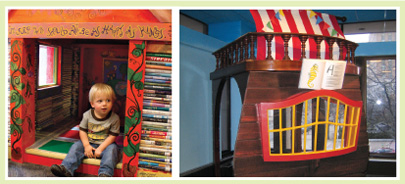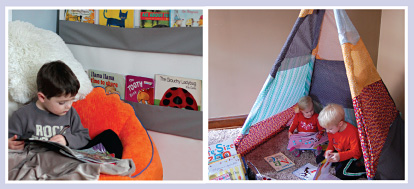Amazing Reading Nooks: Create Cozy, Inventive Reading Havens in Your Library

Reading caves at the Madison (WI) Central Library, designed by Meyer, Scherer & Rockcastle Architecture.
Photograph for SLJ by Narayan Mahon
Why is it that people “curl up” with books? Whether a bibliophile chooses to fling her legs over the side of an armchair, huddle close to a friend, or make a haven from a large cardboard box, the places she chooses all reflect the same idea: There is something about the act of reading that calls out for a safe, snug, and comfortable spot.
Perhaps it’s only when your body, whether you’re five or 85, feels sheltered that your imagination is free to inhabit the world you find in the pages of a novel.
In the reading areas and nooks pictured here, some spaces and furniture are the products of complex architecture plans and methodical design. Others, such as window seats and bean-bag chairs, are seemingly simple in comparison, but no less welcoming. You’ll find a wide visual range of all types of spaces in this sampling—along with DIY tips and notes from architects and librarians about what makes a great reading spot for children and teens.
Inspired by Nature
Bringing the outdoors indoors is a reliable strategy for creating appealing spots to nestle and explore, as these designs show.
See larger images with captions.
Sensational Structures
Child-scaled shelters—such as the pirate ship and mini-house pictured here—feed the imagination while providing an appealing refuge for young patrons.
 See larger images with captions.
See larger images with captions.
Do It Yourself
You don’t need a large budget to create reading areas with a big allure, as Karen Whiteside and Nicolette Lennert, co-creators of “The Classroom Creative” blog, prove. Inviting interiors “can be done on a dime,” says Lennert. “Ask parents, shop clearance racks, and, of course, hit garage sales and thrift shops for books.”
Eight DIY Tips
- “Score carpet squares, giant pillows, bean bags, and, especially, kid-sized lawn chairs and kiddie pools on summer clearance!” suggests Lennert.
- Have kids bring sleeping bags in for D.E.A.R (Drop Everything And Read) time. Lennert did this with first-graders, and the classroom was “pin-drop silent.”
- String holiday lights and sheets between bookcases to create a comfy tent.
- Add a few pillows to a blow-up pool to create an oasis.
- Decorate using old hardcovers.
- In general: pillows, pillows, pillows!
- Check out independent bookstores and children’s museums for ideas.
- Comb Pinterest for inspiration.
 See larger images with captions.
See larger images with captions.
Echo Your Environment
Does your library reflect a sense of place? This range of designs by CK Design International, based in Sydney, Australia, takes note of neighborhood and regional features, whether cultural or natural. “Our clients like us to find something that adds to the local identity and is different from other libraries,” says director Cecilia Kugler.
The West Ryde Library, located in a Sydney suburb, was completed in 2005. A local miniature train park inspired the theme.
 See larger images with captions.
See larger images with captions.
Carving out a Haven
It can be a challenge to create reading hideouts in a high-traffic public area, but the Queens (NY) Library has accomplished just that—and achieved “what I call ‘nookdom,’ or creating the feeling of being in a nook,” says Queens Library operations project manager Gillian Miller. For instance, “We try to include deep window seats where we can.” The right lighting and colors also make spaces feel inviting. “For every child, there is a different ‘great’ space,” adds Miller. “It may be the ability to gather their friends around a good picture book. Or, it is the feeling of being able to disappear into the text and block out everything else.”
 See larger images with captions.
See larger images with captions.
A Core Design Element: Books
In these reading areas at New York City libraries, playful design features create the sense of delineated areas within large, flowing spaces. Books are always the anchors, however. “We love books and we love to read,” says architect Jennifer Sage of Sage and Coombe Architects, which has designed numerous reading rooms for the New York Public Library (NYPL) system. “And anything that encourages children to do the same will surely enrich their lives, offer them intellectual satisfaction, and prepare them to meet challenges ahead.”
 See larger images with captions.
See larger images with captions.
Caves and Pods
An innovative overhaul transformed a portion of the Madison (WI) Central Library into a sleek, sprawling children’s area with naturalistic motifs. Meyer, Scherer & Rockcastle Architecture’s (MSR) reconstruction of the 45-year-old, 95,000 square-foot facility earned the American Public Works Association, Wisconsin Chapter, Project of the Year Award for 2014.
 See larger images with captions.
See larger images with captions.
Going Mobile
For grown-ups, a vehicle takes you somewhere else. But for many kids, a boat or passenger car or truck is a destination in itself. What better place to park one’s self and crack open a book!
RELATED
The job outlook in 2030: Librarians will be in demand
The job outlook in 2030: Librarians will be in demand
ALREADY A SUBSCRIBER? LOG IN
We are currently offering this content for free. Sign up now to activate your personal profile, where you can save articles for future viewing


 See larger images with captions.
See larger images with captions.



Add Comment :-
Be the first reader to comment.
Comment Policy:
Comment should not be empty !!!